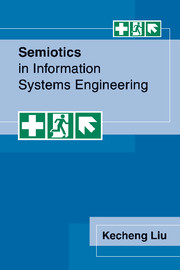Book contents
- Frontmatter
- Contents
- Preface
- 1 Introduction
- Part one Semiotic framework and methods
- 2 Understanding semiotics
- 3 A semiotic framework for information systems
- 4 A semiotic approach to information systems development
- 5 Knowledge representation and information analysis
- 6 Semantic Analysis
- 7 Pragmatics and communication
- 8 The social layer: modelling organisations as information systems
- Part two Applications
- Appendix A Semantic templates and surrogate specification
- Appendix B LEGOL applications in the CRIS case
- Bibliography
- Index
4 - A semiotic approach to information systems development
Published online by Cambridge University Press: 19 September 2009
- Frontmatter
- Contents
- Preface
- 1 Introduction
- Part one Semiotic framework and methods
- 2 Understanding semiotics
- 3 A semiotic framework for information systems
- 4 A semiotic approach to information systems development
- 5 Knowledge representation and information analysis
- 6 Semantic Analysis
- 7 Pragmatics and communication
- 8 The social layer: modelling organisations as information systems
- Part two Applications
- Appendix A Semantic templates and surrogate specification
- Appendix B LEGOL applications in the CRIS case
- Bibliography
- Index
Summary
Development of a computerised system normally goes through several stages, and this whole process is termed a system development ‘lifecycle’. There are various lifecycle definitions (see Leslie (1986), Macro & Buxton (1987), Olle et al. (1991) for example). Many researchers have been engaged in bettering methods for each of the phases in a lifecycle. Some of the methods are aimed at one of the phases while others are claimed to be useful for more than one of them. Recently, a great deal of attention has been paid to user requirement analysis and specification. This is because, on examining the sources of difficulty for large systems projects, we find that the incorrect code is a relatively insignificant factor, dwarfed by incorrect functional specification and (even more significantly) incorrect requirements (Boehm 1981; Goguen 1992).
There are many ways to phase activities in systems development. Macro & Buxton (1987) point out that many models may be excessively simple while others are extremely elaborate. In general, activities of systems development can be grouped under a few headings: conceptualisation of systems scope, requirement analysis, systems design, implementation, validation, acceptance, maintenance, and, finally, obsolescence (which may be followed by activities of developing a new version of the system). The research programme MEASUR (Stamper 1993) has developed a set of methods to deal with all aspects of information systems development.
- Type
- Chapter
- Information
- Semiotics in Information Systems Engineering , pp. 37 - 48Publisher: Cambridge University PressPrint publication year: 2000



